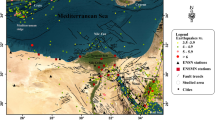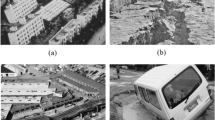Abstract
Liquefaction is a complex phenomenon where the soil is subjected to high strain levels due to dynamic loading at the time of seismic events, contributing to severe damage and collapse of the structures. The effect of liquefaction can be predicted in three stages, i.e., evaluation of susceptibility, hazard and deformations. Soil susceptibility to liquefaction can be assessed using the geotechnical properties such as grain size, age of the soil deposit, penetration resistance of the soil, whereas hazard can be assessed in terms of factor of safety estimated against liquefaction. In the present study, one-dimensional equivalent linear ground response analysis has been carried in the study area Vishakhapatnam, Andhra Pradesh (India) and the surface peak ground acceleration (PGA) has been estimated using DEEPSOIL. The surface PGA values obtained have been used in liquefaction hazard assessment using stress-based method (SBM) and energy-based method (EBM). Hazard maps were generated from the estimated values of PGA and factor of safety against liquefaction (F L). The surface PGA values obtained are in the range of 0.09–0.14 g which are higher than 0.1 g (limiting value provided by Seismic code of India (IS: 1893-2002)). It is observed that the locations in the central part of the city are prone to higher accelerations comparatively. From liquefaction potential assessment, it is evident that most of the locations in northern and central parts of the city are prone to liquefaction. As the study area has two operational ports and is highly industrialized, findings from the present study will be helpful in retrofitting, analysis and design of structures, therefore, solving practical challenges in structural and geotechnical engineering.













Similar content being viewed by others
References
Akhila M, Ghosh C, Satyam DN (Sep 2012) Detailed ground response analysis at Park Hotel in Kolkata city, India. In: 15 World Conference on Earthquake Engineering (Lisbon)
Anbazhagan P, Sitharam TG, Vipin KS (2009) Site classification and estimation of surface level seismic hazard using geophysical data and probabilistic approach. J Appl Geophys 68(2):219–230
Andrus RD, Stokoe KH (1997) Liquefaction resistance based on shear wave velocity (No. Technical Report NCEER-97)
Berrill JB, Davis RO (1985) Energy dissipation and seismic liquefaction of sands: revised model. Soils Found 25(2):106–118
Bird JF, Bommer JJ (2004) Earthquake losses due to ground failure. Eng Geol 75(2):147–179
Boulanger RW, Idriss IM (2004) Evaluating the potential for liquefaction or cyclic failure of silts and clays. Center for Geotechnical Modeling, Davis, California, p 131
Chapman R, Lisle JC, Mo JN, Paul E, Simcock A, Willmott JC, Leslie JR, Price HG, Walker PM, Bacelar JC, Garrett JD (1983) Rotational behavior at high spin in Hf 168. Phys Rev Lett 51(25):2265
Davis RO, Berrill JB (1982) Energy dissipation and seismic liquefaction in sands. Earthq Eng Struct Dyn 10(1):59–68
Figueroa JL, Dahisaria N (1991) An energy approach in defining soil liquefaction. In: 2nd International conference on recent advances in geotechnical earthquake engineering and soil dynamics
Figueroa JL, Saada AS, Liang L, Dahisaria NM (1994) Evaluation of soil liquefaction by energy principles. J Geotech Eng 120(9):1554–1569
Ganapathy GP, Rajawat AS (2012) Evaluation of liquefaction potential hazard of Chennai city, India: using geological and geomorphological characteristics. Natl Hazards 64(2):1717–1729
Guo T, Prakash S (2000) Liquefaction of silt-clay mixtures. In: Proceedings of 12th world conference on earthquake engineering. New Zealand Society for Earthquake Engineering
Hashash Y, Phillips C, Groholski DR (2010) Recent advances in non-linear site response analysis. Fifth international conference on recent advances in geotechnical earthquake engineering and soil dynamics, San Diego, California, pp 1–22
Hashash YMA, Groholski DR, Phillips CA, Park D, Musgrove M (2012) DEEPSOIL 5.1, user manual and tutorial. Department of Civil and Environmental Engineering–University of Illinois at Urbana-Champaign
Holzer TL (2008) Probabilistic liquefaction hazard map**. In: Geotechnical earthquake engineering and soil dynamics IV, pp 1–32
Idriss IM (1990) Response of soft soil sites during earthquakes. In: Proceedings of H. Bolton Seed Memorial Symposium, vol 2, No. 4. University of California, Berkeley
Idriss IM, Moriwaki Y, Wright SG, Doyle EH, Ladd RS (1980) Behavior of normally consolidated clay under simulated earthquake and ocean wave loading conditions. In: International symposium on soils under cyclic and transient loading, pp 437–445
Iwasaki T, Tokida K, Tatsuoka F, Watanabe S, Yasuda S, Sato H (1982) Microzonation for soil liquefaction potential using simplified methods. In: Proceedings 3rd international conference on microzonation, Seattle, USA, pp 1319–1330
Kokusho T (2013) Liquefaction potential evaluations: energy-based method versus stress-based method. Can Geotech J 50(10):1088–1099
Kumar BL, Rao GR, Rao KS (2012) Seismic hazard analysis of low seismic regions, Visakhapatnam: probabilistic approach. J Ind Geophys Union 16(1):11–20
Law KT, Cao YL, He GN (1990) An energy approach for assessing seismic liquefaction potential. Can Geotech J 27(3):320–329
Murthy KSR, Subrahmanyam AS, Subrahmanyam V (2012) Tectonics of the eastern continental margin of India. The Energy and Resources Institute (TERI)
Phanikanth VS, Choudhury D, Reddy GR (2011) Equivalent-linear seismic ground response analysis of some typical sites in Mumbai. Geotech Geol Eng 29(6):1109
Satyam ND, Towhata I (2016) Site specific ground response analysis and liquefaction assessment of Vijayawada city (India). Natl Hazards 81(2):705–724
Nemat-Nasser S, Shokooh A (1979) A unified approach to densification and liquefaction of cohesionless sand in cyclic shearing. Can Geotech J 16(4):659–678
Obermeier SF (1989) The new Madrid earthquakes: an engineering-geologic interpretation of relict liquefaction features. U.S. geological survey professional paper 1336-B, p 114
Ramana CV, Bhaskar CH, Rao PP, Reddy TB (2015) Soil quality in four different areas of Visakhapatnam city, Andhra Pradesh, India. Int J Curr Microbiol App Sci 4(1):528–532
Reddy PR, Chandrakala K (2004) Seismicity in and around Ongole, Andhra Pradesh-an appraisal. J Indian Geophys Union 8(2):143–146
Robertson PK, Wride CE (1998) Evaluating cyclic liquefaction potential using the cone penetration test. Can Geotechn J 35(3):442–459
Roy SK, Srinagesh D, Saikia D, Singh A, Kumar MR (2012) Seismic anisotropy beneath the Eastern Dharwar craton. Lithosphere 4:259–268
Satyam DN (2006) Seismic microzonation of delhi region, Indian Institute of Technology Delhi (Doctoral dissertation)
Schnabel PB, Lysmer J, Seed HB (1972) SHAKE: a computer program for earthquake response analysis of horizontal layered sites. Earthquake Engineering Research Centre, University of California, Berkeley, CA, USA, Report No EERC 72-12
Seed HB, Idriss IM (1970) Soil moduli and dam** factors for dynamic response analyses. Report EERC 70-10, Earthquake Engineering Research Center, University of California, Berkeley
Seed HB, Idriss IM (1971) Simplified procedure for evaluating soil liquefaction potential. J Soil Mech Found Div 97:1249–1273
Seed HB, Peacock WH (1971) Test procedures for measuring soil liquefaction characteristics. J Geotech Eng Div ASCE 97(8):1099–1119
Seed HB, Sun JI (1989) Implications of site effects in the Mexico City earthquake of Sept. 19, 1985 for earthquake-resistant design criteria in the San Francisco Bay Area of California, vol 89, No. 3. Earthquake Engineering Research Center, University of California
Sitharam TG, Anbazhagan P, Vinod JS (2009) Probabilistic seismic hazard analysis for Bangalore. Nat Hazards 48(2):145–166
Subba Rao N, Madhusudhana Reddy P (2006) Monitoring the groundwater quality in an urban area – An environmental impact assessment and management. J Appl Geochem 8:37–56
Susumu Y (2000) Collection of surface data for the prediction of liquefaction potential (partially quoted from the papers by Ishihara and Yasuda (1991) and TC4 (1999)
Wakamatsu K, Yoshida N, Kiku H (2006) Liquefaction during the 2004 niigata-ken chuetsu earthquake—general aspect and geotechnical and geomorphologic conditions—. Doboku Gakkai Ronbunshuu C 62:236–276
Yoshida N, Kobayashi S, Suetomi I, Miura K (2002) Equivalent linear method considering frequency dependent characteristics of stiffness and dam**. Soil Dyn Earthq Eng 22(3):205–222
Youd TL, Hoose SN (1977) Liquefaction susceptibility and geologic setting. In: Proceedings of 6th world conference on earthquake engineering, vol 6, New Delhi, pp 37–42
Youd TL, Idriss IM (2001) Liquefaction resistance of soils: summary report from the 1996 NCEER and 1998 NCEER/NSF workshops on evaluation of liquefaction resistance of soils. J Geotechn Geo Environ Eng 127(4):297–313
Youssef MAH (2009) DEEPSOIL. http://www.geoengineer.org/software/applications-deepsoil.html
Author information
Authors and Affiliations
Corresponding author
Rights and permissions
About this article
Cite this article
Putti, S.P., Satyam, N. Ground response analysis and liquefaction hazard assessment for Vishakhapatnam city. Innov. Infrastruct. Solut. 3, 12 (2018). https://doi.org/10.1007/s41062-017-0113-4
Received:
Accepted:
Published:
DOI: https://doi.org/10.1007/s41062-017-0113-4




